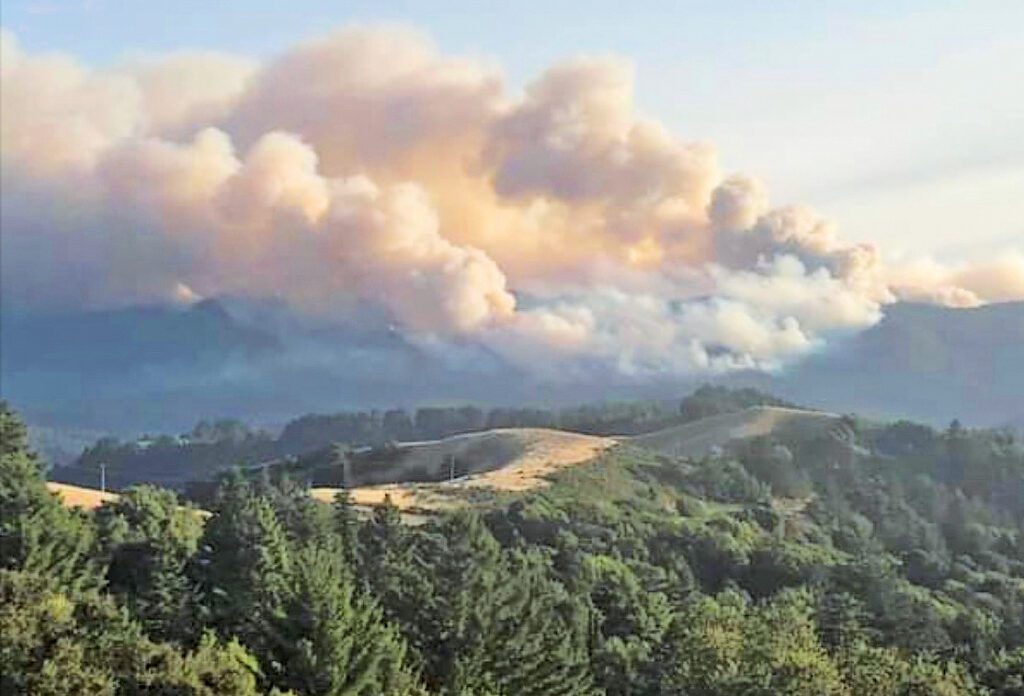For Palo Alto Fire Chief Geo Blackshire, the best type of home to come across during a fire is an empty one. It’s even better when the residents have also left their home adequately prepared for the risk of fire by keeping vegetation several feet away from the exterior.
“I can go on and on about what the community can do to really eliminate that risk of evacuation and rescue that we’d have to engage with, instead of just trying to go out there and protect homes,” he said.
As wildfire season approaches in Palo Alto, Blackshire and other emergency responders are continuing to incorporate feedback from a third-party audit completed earlier this year that found several areas of improvement in the city’s mitigation strategies. Meanwhile, Utilities Department crews are plowing ahead with a multi-year effort to transfer underground about 49,200 feet of electric overhead distribution lines in the Palo Alto Hills area to minimize fire risk, a project that is now nearing completion.
“Folks are saying, ‘What are you doing about wildfire mitigation?’ That’s what we’re doing,” Mayor Ed Lauing said at a press briefing in August. “Up there, which is one of the hottest spots in town, we’re spending that kind of money.”
he audit from Baker Tilly lauded the undergrounding efforts as a key strategy and investment from Palo Alto, stating that “lines cannot be damaged by trees or high winds which can spark fires by falling on vegetation below.” The undergrounding project began in 2021 with a price tag of $11 million. In total, the city will underground about nine miles of power lines.
The power lines in the Foothills serve approximately 300 Palo Alto residents, and as of August 2025, the undergrounding is about 80% complete, according to Director of Utilities Alan Kurotori.
“We’re also providing fiber that’s going to create more robust communications to the fire stations,” Kurotori said. “So we’ll have better communications, and we can put better sensors out there.”

It was not long ago that the foothills faced the imminent risk of a wildfire in the neighborhood. The CZU Lighting Complex fires scorched tens of thousands of acres in San Mateo and Santa Cruz counties in 2020, narrowly avoiding the Palo Alto hills due to shifting winds.
More recently, the Edgewood Fire in August burned about 10 acres in Woodside, just north of Palo Alto. Fire officials said they were lucky that the blaze was not more disastrous.
Due to these close calls in the past, Palo Alto also declared wildfire mitigation a major priority for the city in 2025, one piece of a broader public safety priority.
Kurotori said the undergrounding project is on schedule to be complete by the end of the fiscal year, in June 2026. Pandemic-era supply chain issues and inflation could have delayed the project, which is why some of the remaining work is being saved for next year, he added.
“Some of the equipment had a longer lead time of a year, so we would work around that section, and then we’ll come back and finalize that work,” he said.
The underground work is part of a broader plan by Palo Alto and other jurisdictions to bolster wildfire protection. Another key component is education. This week, the City Council joined the national call to declare the week of Oct. 5 as Fire Prevention Week, which it did at its Monday night meeting. The proclamation of Fire Prevention Week happens every year, Blackshire said, but the focus for 2025 is on lithium-ion batteries and the additional fire hazard they pose.
The main problem with lithium-ion batteries is how ubiquitous they have become in everyday life, Blackshire said, from laptop chargers to electric scooters and vehicles.
“The issue with lithium chemistry batteries is they can have what’s called thermal runaway,” said Ken Dueker, Office of Emergency Services Chief. “So once they get too hot, or one cell melts down, it can just cause a cascade, and once that happens, it’s extremely difficult to stop that chemical reaction.”
Part of this year’s campaign in Palo Alto, Blackshire and Dueker said, is educating residents about proper storage around lithium-ion batteries to prevent fires from breaking out — and if the batteries do experience thermal runaway, preventing them from causing major injuries or damage. For residents, that means avoiding third-party charging cables for devices that use lithium-ion batteries because the amperage may not be appropriate. It also means charging small devices on solid surfaces like a side-table instead of a couch or bed, and charging larger devices such as e-scooters outside the home as an extra precaution.
Outside the campaign, fire and emergency responders also meet annually with residents of the Palo Alto Hills, the verdant neighborhood near the Foothills Nature Preserve that is most at risk should a fire break out. Between the abundance of dry vegetation and topography of the foothills, homes and residents face heightened risk.
“California, with or without people, has always been designed to burn by nature. It burned long before we inhabited California, and it will continue,” Blackshire said. “Now we have this human component, and that adds a different type of hazard to the Foothills.”
Unlike in previous years, city staff held a larger town hall with multiple neighborhood groups instead of individual ones — leading to a more robust turnout, Blackshire said. This year around 50 residents turned out, according to chief communications officer Meghan Horrigan-Taylor, but Blackshire said in the past they “would be lucky to get 10 residents.”
“I can’t tell you how much the challenge is in really getting the engagement of the residents in the community in the Foothills,” he said. “I don’t say they don’t take this seriously, but I think the longer that (a fire) doesn’t happen, it gives people more comfort that it may not.”
For example, the audit found that dozens of homes in the Hills neighborhood had outstanding fire code violations at the end of 2023, meaning that residents had not adequately cleared fuel away from their property to reduce wildfire risk. In the Palo Alto Wildland Urban Interface — which is an area identified by the state as a “Fire Hazard Severity Zone” — there are around 130 homes. But the audit found that the city was slacking on inspections for these homes in 2023 due to a lack of data tracking, which the city began improving the following year.
“With improved data tracking and reporting capabilities, the City will be able to better and timelier follow-up with businesses and residents who are not in compliance with the Fire Code and ensure wildfire risk is reduced,” the audit states.
An additional challenge in the Foothills neighborhood is jurisdictional boundaries. Dueker said it is “almost impossible” that a fire breaking out in the Foothills would only impact one jurisdiction, which is why Palo Alto partners with Los Altos Hills and Santa Clara County Fire to alternate staffing at the fire station in the Foothills.
“The last thing we want is people going, ‘Hey, is that your jurisdiction or mine?,’’’ Dueker said.
The cooperation was in evidence during a recent sunny afternoon in the Foothills Nature Preserve, where park rangers and other staff from Marin County, San Jose, Palo Alto and the Midpeninsula Regional Open Space District were coordinating on wildfire prevention training — including running through how they would extract water from Boronda Lake to quench the flames.
Community engagement was a cornerstone of the third-party audit on wildfire mitigation, conducted by Baker Tilly from June 2024 to December 2024 and released to the city and the public on March 31.
For the most part, the audit lauded the city’s existing coordination with regional partners and its ongoing mitigation efforts, such as the power line undergrounding in the Foothills. But the audit also noted the main area for improvement is increasing communication with residents and tracking efforts to do so.
“Staff indicated that recent efforts have not been well attended by residents, making it difficult to assess how engaged and prepared the community is to prevent and respond to wildfires,” the audit states, echoing concerns from Blackshire and Dueker.
Palo Alto uses Everbridge, an emergency management platform, to communicate real-time mass alerts in wildfire situations, and residents must opt in to receive them. At the time of the audit, just 17% of Palo Alto residents were registered, and the audit recommended that the city look for ways to increase that number.
The audit also recommended that the city continue investing in evacuation procedures and making them more clear and accessible for residents.
“From the emergency planning side, everything that (the audit) identified were actually things that we’re already doing or have intent to do,” Dueker said. “In some cases, and this is true with utilities too, sometimes we don’t have the budget to do everything we’d ideally like to do.”
Blackshire added that the audit being conducted by a third party gives the community more trust in its recommendations — even if those recommendations are things that the Fire Department is already working to address, such as public outreach.
“It’s helpful in regards to making sure that we check the boxes that address the risk in the community as it relates to wildfire. One of the issues was public education,” Blackshire said. “We could be doing more, and we’ve made efforts, and I think that is an area, admittedly, where we’ve struggled to get participation from the community. I think this year, we’ve done a little bit better.”
The audit report was initially up for discussion at the June 16 meeting of the City Council, but it was pulled off consent to facilitate a more robust discussion at a future date — and it is currently agendized for the Nov. 3 meeting. In the meantime, emergency services are already incorporating findings and recommendations from the audit.
While wildfire season typically runs from June through October or November, city officials emphasized that the risk of a blaze breaking out in the Foothills is year round.
“There’s still a lot of fuel up there, it’s still dry, if it’s hot enough it’ll burn, and so we’re always cognizant of that, so we don’t let our guard down at all,” Blackshire said. “But we’re very fortunate, so far, that it hasn’t been a disastrous summer.”
This story originally appeared in Palo Alto Weekly. Riley Cooke is a reporter at Palo Alto Weekly and Palo Alto Online focusing on city government.



Leave a Reply
You must be logged in to post a comment.